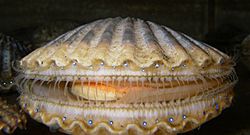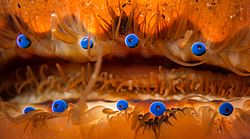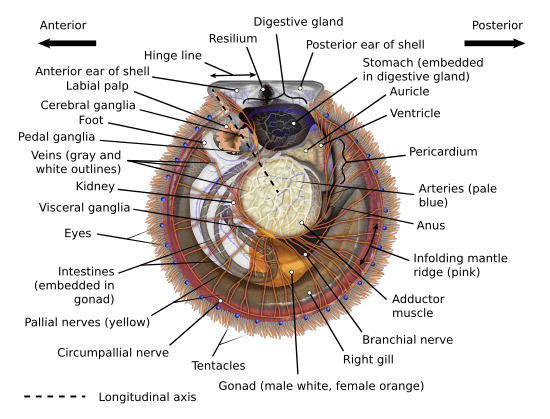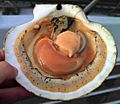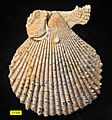Scallop facts for kids
Quick facts for kids Scallop |
|
|---|---|
 |
|
| Scientific classification | |
| Kingdom: | |
| Phylum: | |
| Class: | |
| Order: | |
| Suborder: | |
| Superfamily: |
Pectinoidea
|
| Family: |
Pectinidae
Rafinesque, 1815
|
A scallop is a type of marine bivalve mollusc. It belongs to the family Pectinidae. Scallops live in all the world's oceans.
This is one of the largest families of living bivalves. There are over 300 different kinds of scallops alive today. Their special skill is being able to swim by clapping their shells together. This helps them escape from most of their predators.
Scallops are also well-known as a food source. Like other bivalves, they have two shells. The bottom shell is usually white (about 95%). It can also be orange (4%) or lemon yellow (1%).
The name "scallop" comes from an old French word, escalope, which means "shell". Their shells can grow up to 15 centimetres (6 inches) wide.
Contents
Amazing Scallop Features
Scallops have some very cool features that help them survive and thrive in the ocean.
How Scallops Move
Most scallops can swim! They quickly open and close their shells to push water out, making them jet through the water. This is their main way to escape danger.
However, a few types of scallops attach themselves to rocks when they are adults. Most kinds of scallops rest on sandy parts of the ocean floor. If a starfish or another predator touches them, they quickly swim away.
Scallop Eyes
Scallops have many tiny eyes around the edges of their mantle. Some scallops can have over 100 bright blue eyes!
These eyes cannot see clear shapes like human eyes can. But they are very good at noticing changes in light and movement. This helps them spot predators moving nearby. As an object moves, different eyes detect it, helping the scallop know something is approaching.
Shell Shape
Scallop shells have a special semi-circular shape with ridges. The two shells are very similar and fit together tightly. This strong, ridged shell helps protect them.
The Ctenolium
At some point in their lives, all scallops have a small ridge with tiny teeth. This ridge is near a notch where a special thread, called a byssus, comes out in other bivalves. This unique feature is called the ctenolium.
The ctenolium is important because only scallops have it. Scientists can see it in fossils. This helps palaeontologists (scientists who study fossils) know when they have found a fossil scallop.
Scallop Muscles
Scallops have a large central adductor muscle. This is similar to true oysters. If you look inside a scallop shell, you will see a mark in the middle. This mark shows where this strong muscle attaches to the shell.
The adductor muscle in scallops is bigger and stronger than in oysters. This is because scallops use this muscle to swim, while oysters usually stay in one place.
Food and Digestion
Most scallops are filter feeders. This means they get their food by filtering tiny bits of food from the water. They mainly eat plankton, which are tiny plants and animals floating in the ocean. Sometimes, the plankton even contains baby scallop larvae!
Here is how they eat:
- Siphons bring water into the scallop.
- The water passes over a special filtering structure.
- Mucus (a slimy substance) then traps the food particles.
- Tiny hairs called cilia move the trapped food to the scallop's mouth.
- The scallop then digests the food in its stomach and digestive gland.
- Waste goes through the intestine and leaves the body through the anus.
Scallop Life Cycle
Some scallops, like the Atlantic bay scallop (Argopecten irradians), do not live very long. Others can live for 20 years or even more! You can guess a scallop's age by looking at the rings on its shell, just like tree rings.
The scallop family is special because of the many ways they reproduce.
- Some scallops have only one sex; they are either male or female.
- Other species are hermaphrodites. This means a single scallop has both male and female reproductive organs at the same time.
- A few scallops are male when they are young and become female as they get older.
Female scallops produce red roe (eggs), while male scallops produce white roe. During mating season, scallops release their sperm and eggs into the water. The fertilized eggs then sink to the bottom.
After a few weeks, the baby scallops hatch. These tiny larvae float and drift in the plankton. Eventually, they settle down to the ocean floor to grow. They might attach themselves to something using byssal threads.
Scallops in History
Fossil Record
There are many types of Pectinidae scallops, both living today and found as fossils. The first true Pectinidae, which had the ctenolium, appeared over 200 million years ago (mya). Some scientists think they might have appeared as early as 240 mya.
The Pectinidae family had many species during the Mesozoic era. However, many of them almost disappeared at the end of the Cretaceous period. The scallops that survived then grew and changed quickly during the Tertiary period. Today, there are nearly 7,000 known types of fossil and living Pectinidae.
How Scallops Evolved
The ability of bivalves like scallops to swim came about because of something called the "Mesozoic marine revolution". During the Mesozoic era, new types of predators evolved in the sea. These predators fed on the many shellfish, like brachiopods and bivalves.
These predators are still common today. They include starfish, snails, and crabs. Each predator has its own way of hunting:
- Crabs use force to break shells.
- Some snails drill holes in shells or work on small cracks to get inside.
- Starfish are very common predators. They use their tube feet to clamp onto a shell and pull steadily. A starfish can pull for much longer than a scallop's muscles can hold. After about ten minutes, the shell might open a little. Then, the starfish can slip its stomach inside to dissolve and eat the mollusc.
Because of these dangerous predators, any shellfish that had even a small way to defend itself had a big advantage. Many shellfish developed super-tough shells. Some learned to burrow into the sand. Scallops likely had some basic movement, which quickly improved through natural selection. This helped them become very common in the Mesozoic era.
Some scallops use other clever methods. For example, Chlamys hastata scallops often have sponges growing on their shells. This is a type of mutualism (where two different organisms help each other). The sponge makes it hard for starfish to grab the scallop. It also helps camouflage Chlamys hastata from other predators.
When scallops swim off the sand, they can face new predators like rays, which swim just above the ocean floor. Seabirds might also pick them up and drop them on rocks to break their shells. But getting away from starfish, which are very common near the shore, is a huge advantage for scallops.
Origins
Scientists have studied the Pectinidae family and found that they are monophyletic. This means they all developed from a single common ancestor. The direct ancestors of today's scallops were similar bivalves from the Entoliidae family.
Scallops as Food
Scallops are a very popular food around the world.
Fishing and Farming Scallops
The biggest place for catching wild scallops is off the northeastern United States and eastern Canada. This is where the Atlantic sea scallop (Placopecten magellanicus) is found. Most other scallops caught globally come from Japan (both wild and farmed) and China (mostly farmed Atlantic bay scallops). In 2005, China produced 80% of the world's scallops!
Cooking Scallops
Scallops are popular in both Eastern and Western cooking. They have two main parts of meat inside their shell:
- The adductor muscle is white and meaty. This is the part that is most commonly eaten.
- The roe, also called "coral," is red, orange, or white and has a soft texture.
In Western cuisine, scallops are often sautéed in butter, or they can be breaded and deep fried. The byssus (sometimes called the "beard") is usually tough, so it's often thrown away or used to make broth. Sometimes, markets sell scallops with only the adductor muscle. But outside the U.S., scallops are often sold whole, and people eat both the adductor muscle and the roe.
In Japanese cuisine, scallops might be served in soup or prepared as sashimi (raw slices) or sushi. At a sushi bar, hotategai (帆立貝, 海扇) is the traditional scallop served on rice. Kaibashira (貝柱) can mean scallop, but it can also be the adductor muscle from other shellfish like mussels, oysters, or clams.
In Cantonese Chinese cuisine, dried scallop is called conpoy (乾瑤柱, 乾貝, 干貝).
Scallop Symbolism
Scallop shells have been used as symbols for a long time in different cultures.
Shell of Saint James
The scallop shell is the traditional symbol of Saint James. It is very popular with pilgrims who travel on the Way of St James to the apostle's shrine in Santiago de Compostela in Spain.
Fertility Symbol

For a very long time, scallops and other hinged shells have represented the feminine side. Many old paintings of Venus, the Roman goddess of love and fertility, include a scallop shell. This helps identify her. A famous example is Botticelli's The Birth of Venus, where Venus stands on a large scallop shell.
Used as a Design
The scallop shell symbol was used in Heraldry (the study of coats of arms) as a badge for people who had made the pilgrimage to Compostela. Later, it became a general symbol for any pilgrimage. Winston Churchill's family coat of arms even includes scallops! However, symbols in heraldry do not always have the same meaning. Sometimes, scallops appear on a coat of arms even if no family member has been on a pilgrimage.
More than 45 towns in France have one or more scallop shells on their coat of arms.
The U.S. state of New York chose the Atlantic bay scallop as its state shell in 1988. In design, "scalloped edges" or "ridges" means a wavy pattern that looks like the edge of a scallop's shell. The Shell petroleum company has used a scallop shell in its logo since 1904.
Images for kids
-
A live opened scallop showing the internal anatomy: The pale orange circular part is the adductor muscle; the darker orange curved part is the "coral", a culinary term for the ovary or roe.
-
Large sculpture by Maggi Hambling titled The Scallop erected in 2003 on the beach at Aldeburgh, England
See also
 In Spanish: Vieira para niños
In Spanish: Vieira para niños


